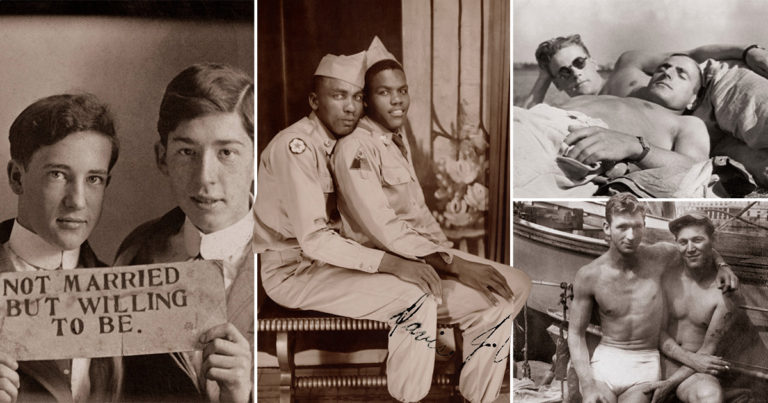

If these pictures got into the wrong hands when they were taken, many of these men could have ended up in prison – or even dead.
They may seem like simple images now, and nothing out of the ordinary, but in fact they show incredible acts of bravery.
They were taken in the U.S. between the 1850s and 1950s when gay relationships were illegal, and even punishable by death until the 1873 in South Carolina.
Hugh Nini and Neal Treadwell, who are married, collected over 2,800 images over the last 20 years from flea markets, estate sales and family archives before digitising them for their book Loving: A Photographic History of Men in Love.
Among the previously unpublished pictures are formal studio portraits and more candid shots at the beach or in homes.
Advertisement
Advertisement
The subjects vary from 19th century working class men to fashionably dressed businessmen, students, soldiers and sailors.
They give a fascinating insight into life as a gay man all the way from the U.S. Civil War through to World War Two and into the 50s.
Their collection now includes photos from all over the world.



Hugo and Neal’s obsession with the pictures started while at an antique shop in Dallas, Texas, where they found an image from around 1920 showing two men in a loving embrace, gazing at one another.
The collectors were curious how this photo—an accidental find—could have survived into the 21st century.
A second photo came to them through an online auction. Presented in a small art deco glass frame with the words ‘yours always’ etched into the glass, it shows two soldiers from the 1940s posed cheek to cheek.
Following these early discoveries, Hugh and Neal began to devote more time to search for photographs.
Commenting on the release of the book, the authors said: ‘The subjects of our photos will publicly narrate their own lives for the first time in history.
‘And far from being ostracized or condemned, they will be celebrated and loved.
‘And the love that they shared will inspire others, as they have us. Love does not have a sexual orientation. Love is universal.’


Soon, the couple became experts at deciphering the platonic from the romantic, picking up on tell-tale signals that the subjects may have been lovers.
From their work, they also picked up trends throughout the ages.
Advertisement
Advertisement
For example, many men started wearing rings in some of the images, though gay marriage was not legal at the time.
One of the earliest photos in the book, from around 1860, shows one of the men wearing a ring on his little finger.
During WWII the appearance of wedding rings, bracelets, and other jewelry serving as symbols of commitment became more common and were worn by many soldiers and sailors.


Another theme that emerged was the photo booth picture, strip which was popular with couples for decades.
The anonymity of the photo booth was a safe place for a couple, as
they could act as the subject, the photographer, and developer.
You can buy Loving: A Photographic History of Men in Love 1850s-1950s, published by 5 Continents, online now.










Do you have a story you want to share?
Email metrolifestyleteam@metro.co.uk to tell us more.
MORE : LGBTQ+ people are more likely to suffer from migraines, scientists say
MORE : Gay penguins become parents as adorable chick hatches from adopted egg
MORE : How to adopt in the UK if you are LGBTQ+
Advertisement
Advertisement